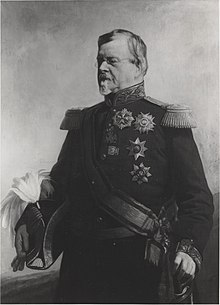Prince Bernhard of Saxe-Weimar-Eisenach (1792–1862)
| Prince Bernhard | |||||
|---|---|---|---|---|---|
 |
|||||
| Born |
30 May 1792 Weimar |
||||
| Died | 31 July 1862 (aged 70) Schloss Belvedere, Weimar |
||||
| Spouse | Princess Ida of Saxe-Meiningen | ||||
| Issue | Princess Luise Wilhelmine Prince Wilhelm Carl Princess Amalie Auguste Prince Edward, Commander-in-Chief, Ireland Prince Hermann Prince Frederick Gustav Princess Anna Amalia, Princess Henry of the Netherlands |
||||
|
|||||
| House | House of Saxe-Weimar-Eisenach | ||||
| Father | Charles Augustus, Grand Duke of Saxe-Weimar-Eisenach | ||||
| Mother | Louisa of Hesse-Darmstadt | ||||
| Religion | Lutheranism | ||||
| Full name | |
|---|---|
| Charles Bernhard |
Prince Carl Bernhard of Saxe-Weimar-Eisenach (30 May 1792 – 31 July 1862) was a distinguished soldier, who, in 1815, after the congress of Vienna, became colonel of a regiment in the service of the king of the Netherlands. He fought at the Battle of Quatre Bras and the Battle of Waterloo where he commanded the 2nd Brigade of the 2nd Dutch Division and became a Chief Commander of the Royal Netherlands East Indies Army
Prince Bernhard, the seventh child of Charles Augustus, Grand Duke of Saxe-Weimar-Eisenach, was born on 30 May 1792 in Weimar. He enlisted in the Prussian army and in 1806 he fought in the army of Hohenlohe-Ingelfingen. By 1809 he had enlisted in the Saxon army and he fought under Marshal Bernadotte at Wagram.
Prince Bernhard's 2nd Brigade of the 2nd Dutch Division (Sedlnitsky) was the first of the Duke of Wellington's forces to arrive at the cross roads of Quatre Bras. Prince Bernhard's brigade (joined later by the 1st Brigade,) held the cross roads at Quatre Bras for almost 24 hours from the late afternoon of 15 June 1815, until about 3 p.m. on the 16 June, preventing Marshal Michel Ney with the left wing of the French L'Armée du Nord from taking the cross roads before the Duke of Wellington and substantial allied forces arrived to reinforce the 2nd Division and fight the Battle of Quatre Bras. The successful holding action by the two brigades of the Dutch 2nd Division was one of the most important actions by any of the coalition brigades in the whole of the Waterloo Campaign.
...
Wikipedia
